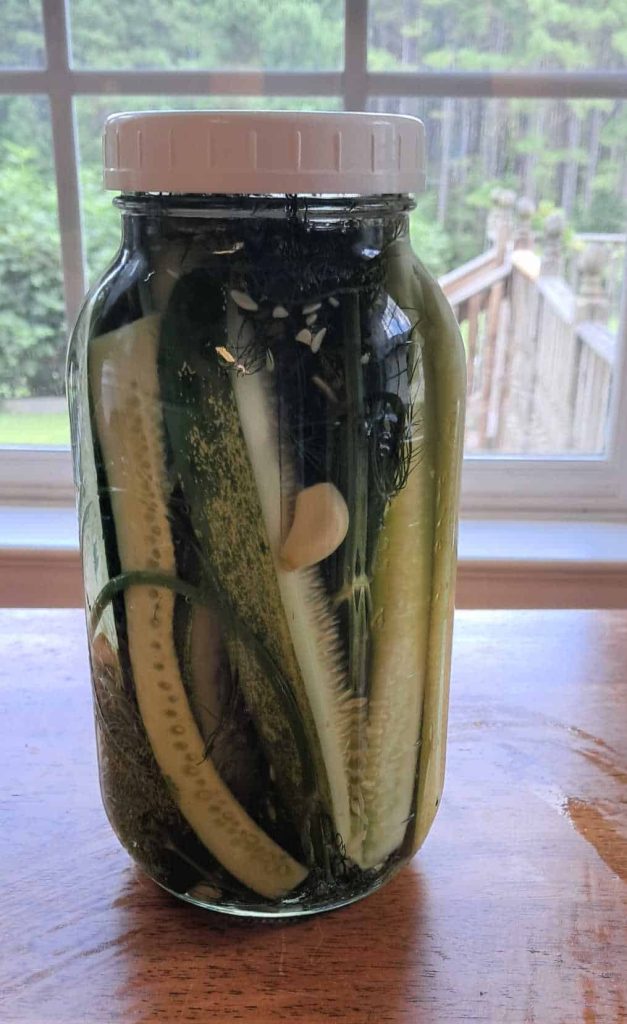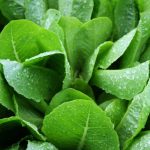Learn how to grow cucumbers in this complete guide. I’ve grown cucumbers my entire life, and I still marvel at the prices of them at the supermarket. I can only imagine that we’re all paying for the transportation, for cucumbers are some of the easiest vegetables to grow. In fact, you may find yourself muttering, “What do I do with all of them?” in a really good year.
We’ve got you covered from seed to plate, with instructions on how to grow cucumbers (in pots, raised beds, and more) and what to do with all those organic cucumbers you may harvest. Ready? Let’s get growing!
Plant Profile: Cucumbers
Botanical Name: Cucumis sativus
Light Requirements: Cucumbers grow best in full sun, requiring a minimum of six to eight hours of direct sunlight each day. A warm, sheltered location helps support vigorous growth.
Soil Requirements: They prefer well-draining, fertile soil with a slightly acidic to neutral pH range of 6.0 to 7.0. Amending the soil with compost or well-rotted manure enhances organic content and improves structure.
Watering Needs: Cucumbers need consistent and deep watering, roughly one inch per week. It’s best to water at the base of the plant to prevent fungal diseases, and mulching helps retain soil moisture and suppress weeds.
Fertilizer Recommendations: Use a balanced fertilizer such as 10-10-10 at the time of planting, then transition to a fertilizer higher in phosphorus once flowers begin to appear. Fertilize every two to four weeks, either by side-dressing or using a liquid feed. Avoid excessive nitrogen, as it promotes leafy growth at the expense of fruit production.

Please note that this post contains affiliate links. As an Amazon affiliate, Home Garden Joy receives a small commission if you purchase products through the links on our website. This does not affect your price in any way. Thank you for supporting Home Garden Joy!
Starting Cucumbers from Seeds
The easiest way to grow cucumbers is from seeds. Seed packages are inexpensive, and cucumber germination rates are usually quite good.
Amend garden soil or the soil in your raised bed with plenty of compost and manure. Then, after all danger of frost is over for your USDA Hardiness Zone, make small hills or mounds where you want to plant the cucumber seeds. I plant three seeds in each mound, but you can also plant just one. Plant the seeds about 1/2 to 1/4 inch deep. Water them daily until they germinate, and keep watering daily until the plant has at least two sets of leaves.
Types of Cucumber: Bush and Vine
Bush and vining cucumbers differ primarily in their growth habits, space requirements, and yield potential.
If space is at a premium, or you don’t have a trellis, plant bush cucumbers.
Bush cucumbers are compact plants that typically grow to about two to three feet in length. They’re ideal for small gardens, raised beds, or containers because they don’t require much room and usually don’t need trellising. While they may produce slightly fewer fruits than vining types, bush varieties are efficient and productive in limited spaces. Popular cultivars include ‘Bush Champion,’ ‘Pickle Bush,’ and ‘Salad Bush.’
I love Burpee’s bush varieties. My dad used to grow these in our suburban New York City area backyard, and we enjoyed delicious cucumbers all summer long. Burpee’s “Bush Sweet Burpless” is a great variety, but there are many other bush-type cucumbers that are great space savers.
Vining cucumbers, on the other hand, grow long, sprawling vines that can reach six to eight feet or more. They benefit from trellising, which keeps the fruit clean, improves air circulation, and saves garden space. Vining types tend to produce more cucumbers over a longer season and are often favored in larger gardens. Many heirloom varieties fall into this category, such as ‘Straight Eight’ and ‘Marketmore’.
Both types have similar care requirements—full sun, fertile soil, consistent watering, and regular feeding—but your choice depends on how much space you have and how you plan to grow them.
Growing Cucumbers in Pots or Containers
If you grow cucumbers in pots or containers, choose bush cucumbers. These space-savers will give you plenty of cucumbers without the long, trailing vines that can rapidly take over your balcony, deck, or porch.
Make sure you use at least a 5-gallon or larger tub or container. Check to ensure it has drainage holes in the bottom to allow excess water to escape. Place soil and compost in the container, then plant bush cucumber seeds in the center of the container, one per pot. Water daily and fertilize weekly, if you choose to use inorganic fertilizers.
Vining Cucumbers Need a Trellis or Supports
If you’re growing cucumbers in garden soil, or growing cucumbers in raised beds, and you choose vining-type plants, you will definitely need trellises or supports. Here at Home Garden Joy, we use Cedar Ridge collapsible trellis. Not only are they sturdy enough for heavy cucumber vines, but they disassemble for flat storage against the shed wall – a plus if you have limited space.

How Do Cucumbers Know to Climb a Trellis?
Cucumber vines climb trellises through a fascinating natural mechanism involving specialized structures called tendrils. These thin, coiling appendages grow from the stem and act like feelers, reaching out in search of support. When a tendril touches something solid—like a trellis, string, or neighboring plant—it responds to the physical contact by curling around it. This reaction, known as thigmotropism, allows the vine to anchor itself and begin climbing upward.
As the plant continues to grow, more tendrils emerge and latch onto nearby supports, helping the vine stabilize and stretch toward sunlight. Gardeners often assist this process by gently guiding the vines or tying them loosely to the trellis until the tendrils take over. Or, you can just let nature take its course. My own cucumbers outgrew their trellis and they’re sprawling all over the raised bed, but I’m fine with that. Sometimes the plants have a mind of their own!
Pests and Diseases
Many of the same pests and diseases that affect squash plants hurt cucumbers, too.
One of the most damaging pests is the cucumber beetle, which feeds on the plant’s leaves, stems, and fruit. Beyond physical damage, these beetles can transmit bacterial wilt—a fast-moving disease that causes rapid wilting and death. I’ve lost several crops in previous years to wilt.
An organic gardening trick I have learned is to plant cucumbers a bit later in the season. I’ve tested this for the past two years, and it seems as if I avoid the majority of the beetles that carry the wilt, probably by growing my plants a little outside of their natural lifecycle. In other words, when they’re feeding or laying eggs, my plants aren’t even in the ground yet. And by the time my cucumbers are growing steadily, they’ve found other plants to bother.
Aphids are another common threat. These small, sap-sucking insects congregate on the undersides of leaves, distorting growth and leaving behind sticky honeydew that fosters sooty mold. Spider mites, although nearly invisible to the naked eye, create noticeable damage through stippling (small pale spots on leaves) which can progress to browning and leaf drop in severe infestations.
Squash bugs pierce plant tissues to extract sap, leading to yellowing and wilting leaves, and their eggs often appear in clusters underneath the foliage. And yes, I’ve had them too. The eggs can be scraped off the leaves and into a jar of soapy water if you find them fast enough.
Powdery mildew and downy mildew are especially prevalent in humid conditions and appear as white or yellowish patches on leaves, spreading rapidly and stunting growth if not managed. Anthracnose is a fungal disease that causes lesions on leaves, leading to holes and eventual leaf die-off, which weakens the plants.
Preventive measures such as selecting disease-resistant varieties, maintaining proper spacing, practicing crop rotation, and encouraging beneficial insects can help reduce these threats.
Harvesting Cucumbers
Cucumbers are pollinated by bees, and once the flowers are out, you’ll see lots of bee activity near the plants! Small cucumbers first appear from the blossoms, then grow rapidly. Watch their growth and harvest them before the green skin turns yellow. The larger, fatter, and yellower the cucumber (unless the variety is explicitly marketed as a yellow-skinned variety), the more seeds inside, and the more bitter or sour the cucumber.
Gently pull or twist the cucumber from the vine. Store it in the refrigerator for maximum shelf life, and enjoy!

Cucumber Recipes: Make Pickles
Oh, how we LOVE refrigerator pickles here at Seven Oaks Farm!


If you have never made refrigerator pickles or tasted one, you are in for a treat. As the name suggests, you simply cut up the cucumbers, add the brine, herbs, and spices, cover the jar, and store it in the refrigerator. After a week or two, you will have crisp, crunchy, delicious cucumbers. They store in the fridge for several months and are absolutely delicious.
Here is our favorite refrigerator pickle recipe.
Home Preserving and Canning Pickles
I’m a big fan of home canning. I taught myself how to can using the Ball Big Book of Home Preserving and my husband’s grandmother’s 1940s graniteware canning pot. You can buy reproductions, but you can’t buy mine – I’m not parting with it!
If you are new to home canning your food, and are nervous about ensuring food safety and quality, there are several ways to learn best practices. You can purchase a book like I did and teach yourself. You can take classes at your local Cooperative Extension office. Many offer evening or weekend workshops in the spring or summer to learn how to safety can foods. Check with your local office for more information.
Another great resource is the National Center for Home Food Preservation from the University of Georgia. They offer free online articles, recipes, resources, and more to help you learn how to can and preserve all types of garden products. They have an extensive pickle recipe section.
Our favorite dill pickle chip recipe, which requires hot boiling water bath canning for proper preservation, is this one from Ball: Bread and Butter Pickles Recipe.
Grow Cucumbers, Reap Pickles (and More)
From pickles to cucumber-yogurt-dill chilled soup, there are many ways to enjoy fresh garden cucumbers. It’s easy to grow your own organic cucumbers, and I hope you give it a try!




